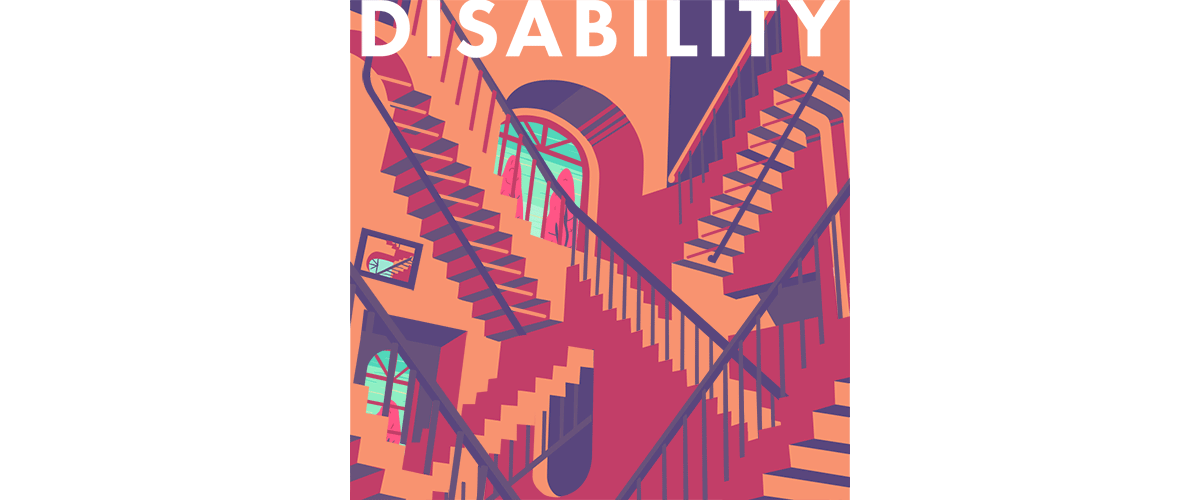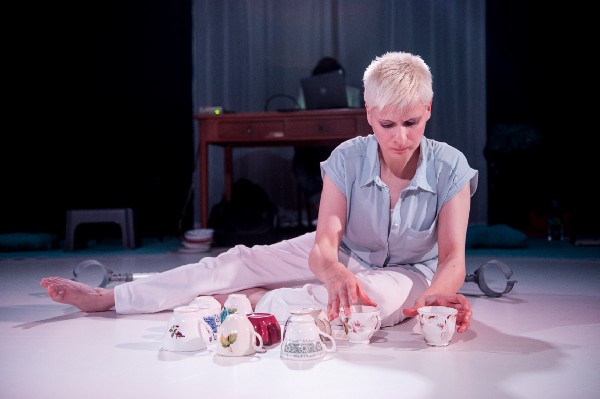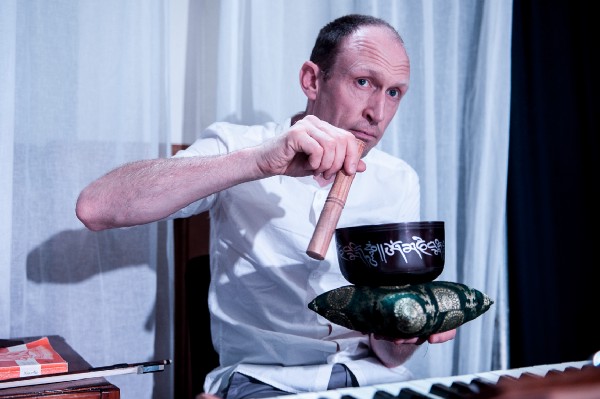

“On the first day was created the earth,” says the godlike voice-over in Claire Cunningham’s solo dance performance Guide Gods, which I saw recently at Düsseldorf’s Tanzhaus NRW. “On the second day was created the four corners of the earth, and carpeted they were in blue. And on these were placed chairs and cushions for the people.”
Barely minutes into the performance, Cunningham–a Glasgow-based dancer, performer, and choreographer–is enacting her goal of inclusive performance. The voice over allows those with visual impairments to experience the set, the performer, and the action. The scene described to us is the set in which we are sitting, “chairs and cushions for the people so they might be comforted” atop sky-blue carpet.
“On the third day was created an archway festooned with crutches. This was the entrance to the world,” the voice-over continues, describing another aspect of the set. “On the seventh day were created people, who entered into the world through the archway,” as the audience did before the performance, and as Cunningham, dressed in white, now does using her own crutches. The archway transforms a common feature of religious sites, where assistive devices are discarded by believers who seek healing, into an image of welcome vulnerability through which we all enter our lives.
“Religion is often talked about as a cause of great division in the world–conflict, even,” Cunningham says aloud, as her words appear in captions projected on walls for the deaf and hard of hearing, and for all of us who find reading text more amenable. “But I–single-handedly–believe I have found something that will bring all faiths together, one unifying ritual in which they all partake.”
I assume that she will tell us how religion oppresses, isolates, and dehumanizes those of us with disabilities. But as I prepare myself for this expected onslaught, she says, “A ritual of welcome, of connection, of communication and generosity. The cup of tea.”


Tea nods to Cunningham’s home country. The people she interviewed for Guide Gods about both their faith and their views of disability served her tea. On the shelves opposite the Archway of Crutches also “stand religious objects, books, and china teacups and saucers.”
What do teacups have to do with religion? Cunningham holds a microphone up to one, and the voice of one of her interlocutors emanates from it. As she goes from teacup to teacup, voices talk about their religions’ views of disability, and how their individual views are similar or different. We also hear the voices of disabled people speaking about their experiences and relationships with religion.
It is upon these teacups that Cunningham dances–yes, you’ve read that right, she dances on teacups–as she upends our preconceptions about both religion and disability. She rivets our attention, her movements from teacup to teacup a metaphor for how we negotiate the steps of our mortal lives. But what she does can’t be reduced to such. Her movements stay with you long after the performance; perhaps, with me, for life.
Cunningham doesn’t let religion or those of faith off the hook. We hear about the numerous religious depictions of disability as a sign of punishment, devilry, or sainthood, as well as about the disenfranchisement of the disabled through lack of physical access to religious worship. She also quotes and sings from religious texts that disparage the disabled–how many times must Christ make the deaf hear and the blind see?
Stepping carefully as she carries the teacups on a tray down some stairs, Cunningham then journeys through the mismatched cups and saucers she places, and listens to, on the performance floor. She confesses that she has stereotyped her religious interviewees, just as sometimes they have stereotyped her because of her disability. Some of the faithful folks she interviewed seem to have been distanced by their religious institutions’ rigid belief systems as much as are the disabled who aren’t provided braille prayer books or accessible places of worship.
In Guide Gods, these ideas are not as pat as they might sound. As delicately balanced as Cunningham’s deft, elegant, and tension-filled choreography on the teacups is her view of the relationship between religion and disability.
The next day, I attend a “tea talk,” at which Cunningham discusses the relationship between disability, arts, and religion. Joining her are Julia Watts Belser, who is an associate professor of Jewish studies at Georgetown University, and Marie Hecke, a theologian at Georg-August-Universität in Göttingen.
“Religious thinkers have not always grappled well with the real complexity of human bodies, or taken seriously the perspectives and experiences of people with disabilities,” Watts Belser says. “As a rabbi and as a wheelchair user who’s deeply engaged in disability culture, I’m passionate about bringing these two worlds together.”
She points to what she has learned from Cunningham. Both religion and theater specifically provide spaces “where large numbers of people with common interests can come together.” But how, she asks, do we create spaces where that happens?
Both religious and theatrical spaces are often specifically tailored to normative bodies, Hecke observes. She asks, “How do we make spaces to allow for flexibility, permission for different ways of attention?”
Cunningham, for her part, has created such a space in Guide Gods: the godlike voice-over, the captions, the different modes of seating. Performance after performance, she also provides what Watts Belser calls “the gift of attention” to each person she interviewed, taking time with people’s stories. “How might religious spaces learn from this?” Watts Belser asks.
The “tea talk” conversation, like Guide Gods, references biblical images of healing that Hecke, recently diagnosed with multiple sclerosis, rebuts: “I am also a good creation. This is how I was made. Creation is not a one-time thing. God is the one who makes new every day.” She continues, “The ongoing changing of my body is part of how I am made and how I am making myself. Identity is malleable. Something that changes. We can recognize these opportunities as sacred.”

“I can’t control what people think,” Cunningham reflects. Referencing the moment in the performance when she carries a tray of teacups, as well as her crutches, down a small set of stairs, she says, “I have to realize that some of the audience will see it as a struggle, not effort, and others will not. An audience isn’t one thing. I can’t always have the intention to educate.”
Though many who experience the work may in the process be educated about disabled lives, that isn’t Cunningham’s main intent. Instead, her performance is focused on including all of us, not only through the creation of an inclusive performance and performance space but also through the subject matter: the challenges and conflicts of faith.
In Guide Gods, the myriad voices radiating from the small teacups strewn on the performance floor animate what we usually see as static. As Cunningham brings the diversely patterned and colored teacups to life in all their strength and fragility, she begins a dialogue that is–all too often–portrayed by both sides as an unmoving argument between us and them.
A plethora of crutches is also a welcoming archway. And a space where we are comforted by carpet and cushions is one where we can think, feel, and be challenged–both despite and because of our differences.


How We Get To Next was a magazine that explored the future of science, technology, and culture from 2014 to 2019. This article is part of our “Disability” Beat, which asks the question: What will it take to include disability in our future debates about diversity? For more dispatches, click the logo.
